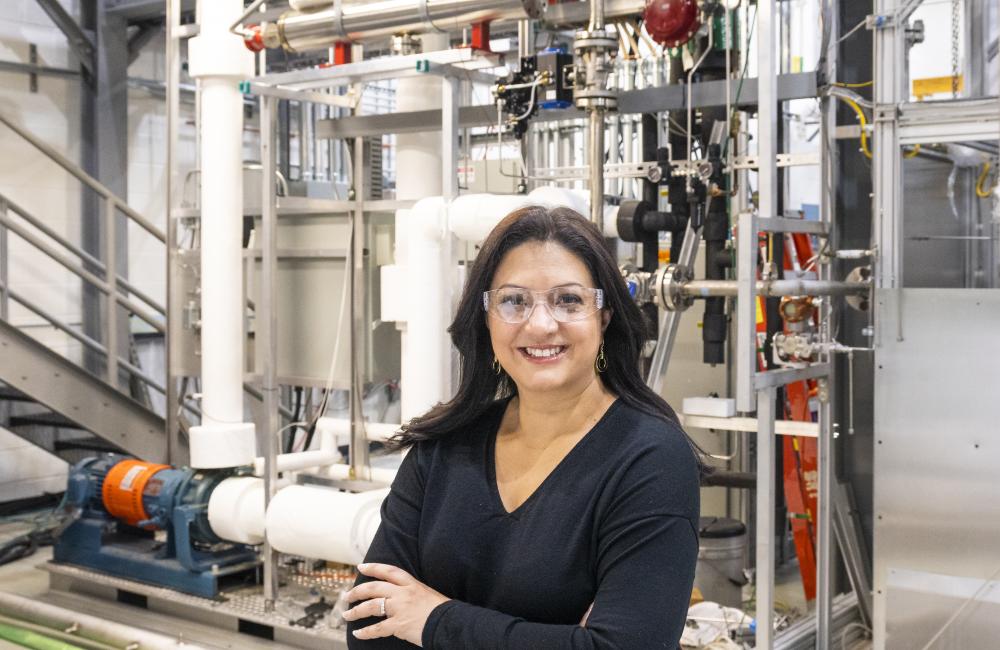Nuclear engineer Nesrin Ozgan Cetiner led ORNL’s collaboration with AMS Corp. to test instrument and control sensors for the next generation of nuclear power reactor technology. Credit: Carlos Jones/ORNL, U.S. Dept. of Energy
Toward the goal of bringing the next generation of nuclear power reactor technology online this decade, Oak Ridge National Laboratory and Analysis and Measurement Services Corporation, or AMS, have successfully completed loop testing of instrument and control sensors for an advanced reactor design for small modular reactors.
“As we advance the technology needed for new reactor concepts, there is a critical need for sensors that can perform inside the operating environment that allow us, in effect, to see what is happening inside the reactor,” said nuclear engineer Nesrin Ozgan Cetiner, who is ORNL’s lead researcher for the project. “These sensors send back data that lets us know if the reactor is safe, reliable and cost effective.”
Using ORNL’s thermosyphon test loop in the thermal hydraulic laboratory, along with a steam test loop built specifically for the experiment, researchers were able to successfully test the performance of nuclear grade resistance temperature detectors, or RTDs, under conditions expected during startup and operation of a natural circulation small modular reactor.
The project, which was successfully completed in March, was initiated under the U.S. Department of Energy’s Gateway for Accelerated Innovation in Nuclear, or GAIN, program. GAIN was established in part to make government research facilities more accessible to private sector companies that hope to commercialize innovative nuclear power technology.
“The components we tested are essential to the safe and efficient operation of the next generation of nuclear energy technology,” said Alex Hashemian, AMS research engineer and project manager. “This work we are performing under DOE’s GAIN program supports the successful deployment of the first U.S.-based small modular reactors by the mid-2020s.”
AMS and ORNL will use the findings to create guidance that will be shared with commercial companies, including sensor suppliers as well as developers of small modular reactors.
“Our research results will help guide industry partners in the selection of nuclear-grade RTDs suitable for safety-related temperature measurements of the reactor coolant and main steam of small modular reactors,” Cetiner said. “ORNL’s vast array of experimental facilities and resources in general to test the sensors in realistic operating conditions is one reason that AMS partnered with us on this project.”
One area of particular importance that researchers addressed was whether the instruments being tested could meet the response-time requirements for detecting energetic transient phenomena of interest. One example is detection of a high-energy line break, an event that would require the safe shutdown of the reactor.
“Because the signals involved are used to initiate a safe shutdown of the reactor during an incident, validation of the instruments’ ability to perform is subject to strict regulatory scrutiny,” Cetiner said.
While ORNL’s thermosyphon’s primary loop could handle most of the testing, researchers turned to the lab’s Facilities and Operations Directorate, or F&O, for help in constructing a steam loop specifically for the project.
“This was the first time that I know of that F&O helped conduct a research experiment at the main steam plant,” said Ian Woods, an F&O facility engineer at ORNL who worked on the project under the direction of ORNL’s Jason McLemore, operations manager. “We installed a small steam test station at the main plant specifically for this experiment to allow the researchers to test their equipment in a real-world operating environment.”
The team is now finalizing their findings and preparing to share them with industry.
“Ultimately our goal is to help DOE’s Office of Nuclear Energy in its mission of helping the nation create a new generation of reactor technology,” Cetiner said. “The commercial companies who will build the reactors and manufacture the equipment need our research insights to ensure that these instruments perform as intended.”
UT-Battelle manages ORNL for DOE’s Office of Science, the single largest supporter of basic research in the physical sciences in the United States. The Office of Science is working to address some of the most pressing challenges of our time. For more information, please visit https://energy.gov/science. — Amy Reed


